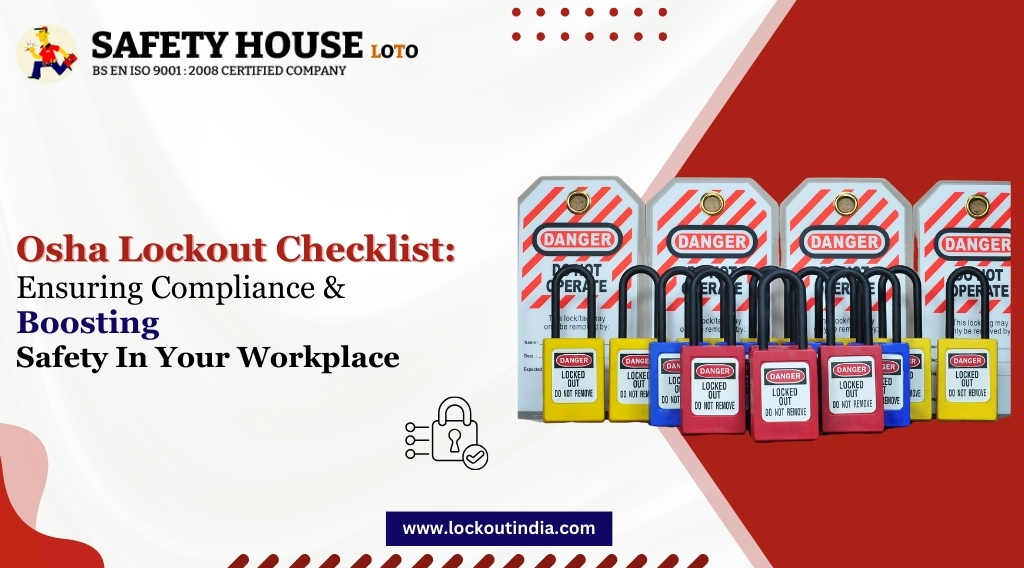
A Deep Dive into OSHA Locks: Best Practices for Lockout-Tagout Safety
In industries where machinery and equipment pose hazards to workers, ensuring safety through effective lockout-tagout (LOTO) procedures is paramount. The Occupational Safety and Health Administration (OSHA) sets forth guidelines for these procedures, emphasizing the importance of using proper locking mechanisms to prevent accidental equipment startup during maintenance. In this blog, we’ll explore OSHA locks, their significance, and best practices for implementing lockout-tagout safety, particularly in the context of products offered by manufacturers like Safety House Loto.
Understanding OSHA Locks
OSHA locks are specialized locking devices designed to secure machinery and equipment during maintenance or repair work. They prevent the accidental release of hazardous energy, safeguarding workers from potential injuries. These locks are integral to any lockout-tagout program and come in various forms, including padlocks, hasps, and lockout devices for specific equipment.
Why OSHA Locks Matter
The primary goal of using OSHA locks is to ensure that machinery remains inoperable while maintenance personnel are working on it. Failure to adhere to lockout-tagout procedures can result in severe injuries or even fatalities. According to OSHA statistics, the lack of proper lockout procedures is one of the leading causes of workplace accidents.
By implementing a robust lockout-tagout program that utilizes OSHA locks, employers can significantly reduce the risk of accidents, comply with regulatory standards, and foster a culture of safety within their organization.
Key Components of an Effective Lockout-Tagout Program
Creating a successful lockout-tagout program involves several critical components:
1. Written Procedures
Documenting lockout procedures for each piece of equipment is essential. These procedures should detail the steps for shutting down, isolating, and securing machinery. Clearly written procedures ensure that all employees understand how to perform lockout-tagout safely.
2. Training and Awareness
Proper training for all employees who will be involved in lockout-tagout procedures is crucial. This training should cover the importance of using OSHA locks, the types of locks available, and how to apply them correctly. Regular refresher training can also help reinforce safe practices.
3. Use of OSHA Locks
Selecting the appropriate OSHA locks is a key aspect of an effective lockout-tagout program. Manufacturers of lockout products, like Safety House Loto, provide a variety of locking solutions designed to meet different needs. It’s essential to choose locks that are durable, tamper-resistant, and easily identifiable.
Types of OSHA Locks
- Padlocks: These are versatile and can be used in various applications. Choose lockout padlocks that have a unique key for each lock to ensure that only authorized personnel can access the machinery.
- Lockout Hasp: This device allows multiple padlocks to be used on a single piece of equipment. Each worker involved in maintenance can apply their lock, ensuring that the equipment cannot be operated until all locks are removed.
- Dedicated Lockout Devices: For specific types of machinery, dedicated lockout devices provide an added layer of security. These devices are designed to fit specific equipment, preventing it from being powered on while maintenance is underway.
4. Regular Inspections
Routine audits of the lockout-tagout program are essential for ensuring compliance and effectiveness. Regularly inspect the locks, procedures, and employee compliance to identify any areas for improvement. An effective inspection routine helps to maintain a high standard of safety and accountability.
Best Practices for Lockout-Tagout Safety
Implementing best practices for lockout-tagout safety can further enhance workplace safety and ensure compliance with OSHA standards.
1. Always Use Locks and Tags
Every time maintenance is performed, ensure that OSHA locks and tags are used. Tags should indicate that the equipment is locked out and should provide the name of the person responsible for the lockout. This adds an additional layer of accountability.
2. Communicate Clearly
Before starting maintenance work, communicate with all affected employees about the lockout procedures. Ensure everyone understands which equipment will be locked out and why.
3. Follow the Steps Diligently
Adhere to the established lockout procedures rigorously. Skipping steps or rushing through the process can lead to dangerous mistakes. Make sure to follow each step precisely to ensure maximum safety.
4. Keep Keys Secure
Lockout keys should be kept in a secure location, accessible only to authorized personnel. This prevents unauthorized access and ensures that only those trained in lockout procedures can operate the equipment.
5. Incorporate a Checklist
Using a lockout-tagout checklist can help ensure that no steps are missed during the procedure. A checklist can serve as a handy reference for employees, reminding them of the necessary steps to follow before beginning maintenance work.
Conclusion
OSHA locks are essential components of an effective lockout-tagout program, crucial for maintaining workplace safety. By understanding their importance and implementing best practices, organizations can significantly reduce the risk of accidents and injuries. Safety House Loto, as a leading manufacturer of lockout products, provides a range of durable and effective OSHA locks that can help companies comply with regulations and enhance their safety measures.
Investing in lockout-tagout safety is not just about compliance; it’s about creating a culture of safety that protects employees and fosters productivity. By prioritizing OSHA lock usage and ensuring adherence to best practices, businesses can create safer work environments for everyone involved.

OSHA Lockout/Tagout Compliance: Best Practices for Effective Implementation
Ensuring workplace safety is a priority for any organization, and one of the critical aspects of this is adhering to OSHA’s Lockout/Tagout (LOTO) standards. These regulations are designed to prevent accidental equipment start-up and release of hazardous energy during maintenance and servicing, which can lead to serious injuries or fatalities. Successfully implementing Lockout/Tagout procedures is vital for complying with OSHA guidelines and safeguarding employee safety.
Understanding OSHA Lockout/Tagout Standards
The Occupational Safety and Health Administration (OSHA) has set forth strict regulations concerning the control of hazardous energy through the Lockout/Tagout (LOTO) standard. These regulations require employers to establish an energy control program, including specific procedures to isolate and de-energize machines and equipment before maintenance or servicing.
The key to effective compliance lies in understanding the OSHA LOTO standard, which applies to all forms of hazardous energy, including electrical, mechanical, hydraulic, pneumatic, chemical, and thermal. The standard mandates the use of proper lockout devices, such as OSHA locks, to prevent equipment from being accidentally energized. These devices must be durable, standardized, and substantial enough to withstand the conditions of the workplace.
Best Practices for Implementing OSHA Lockout/Tagout Procedures
1. Developing a Comprehensive Energy Control Program
An effective energy control program is the foundation of OSHA LOTO compliance. This program should include detailed procedures for shutting down, isolating, and de-energizing equipment. It should also outline the steps for applying and removing lockout devices, as well as testing the effectiveness of energy isolation.
2. Training Employees on LOTO Procedures
Thorough training is essential for effectively implementing LOTO procedures.. All employees involved in maintenance or servicing tasks should receive thorough training on the specific procedures for the equipment they work on. This training should cover the importance of using OSHA locks and other lockout devices, the hazards associated with uncontrolled energy, and the steps to take in case of an emergency.
3. Selecting the Right Lockout Devices
The selection of lockout devices is critical for ensuring compliance with OSHA standards. Manufacturers of lockout products, like Safety House Loto, offer a wide range of devices designed to meet the specific needs of different industries. When selecting lockout devices, it is important to choose products that are durable, tamper-proof, and easy to use. OSHA locks, for example, should have a unique key or combination to ensure that only authorized personnel can remove them.
4. Regular Inspection and Maintenance
Regular inspection and maintenance of lockout devices and procedures are essential for ensuring ongoing compliance. OSHA requires periodic inspections of the energy control program to verify that it is being followed correctly. These inspections should include a review of the lockout devices in use, such as OSHA locks, to ensure they are in good working condition and properly applied.
5. Continuous Improvement and Updates
Safety standards and workplace environments are constantly evolving, making it essential to regularly review and update your energy control program. This includes staying informed about changes in OSHA regulations and advancements in lockout products. Working with a reputable manufacturer of lockout products ensures that your organization has access to the latest and most effective devices for maintaining compliance.
Benefits of Compliance with OSHA LOTO Standards
Complying with OSHA LOTO standards offers several benefits beyond avoiding penalties and fines. It significantly reduces the risk of workplace injuries and fatalities, thereby improving overall employee morale and productivity. Additionally, having a robust energy control program can enhance your organization’s reputation as a safe and responsible employer.
By implementing best practices for OSHA Lockout/Tagout compliance, organizations can protect their workers from hazardous energy, maintain a safe work environment, and ensure adherence to regulatory requirements. Collaborating with a trusted manufacturer of lockout products, like Safety House Loto, provides the necessary tools and expertise to effectively manage hazardous energy and safeguard your workforce.
Conclusion
Ensuring OSHA Lockout/Tagout compliance is not just about meeting regulatory requirements—it’s about protecting your most valuable asset: your employees. By developing a comprehensive energy control program, providing proper training, selecting the right lockout devices, and continuously improving your procedures, you can create a safer workplace and foster a culture of safety. Investing in quality lockout products from reputable manufacturers ensures that your organization remains compliant and that your employees are well-protected from hazardous energy risks.

Minimize Downtime, Maximize Safety: The Importance of OSHA LOTO in Construction
The Importance of OSHA LOTO in Construction
In the dynamic and potentially hazardous environment of construction sites, ensuring worker safety is paramount. One of the critical safety protocols mandated by OSHA (Occupational Safety and Health Administration) is Lockout/Tagout (LOTO). This procedure is designed to safeguard workers from the unexpected startup of machinery or equipment during maintenance or servicing activities, thus preventing injuries and fatalities.
Understanding OSHA LOTO Regulations
OSHA’s Lockout/Tagout (LOTO) standard (29 CFR 1910.147) mandates that employers implement specific practices and procedures to control hazardous energy sources during servicing and maintenance of machines and equipment. The key elements of LOTO include:
- Energy Control Program: Employers must develop, implement, and enforce an energy control program that outlines procedures for isolating energy sources and ensuring the effective lockout/tagout of equipment.
- Lockout Devices: These are physical devices such as padlocks that are used to immobilize machinery or equipment to prevent hazardous energy release.
- Tagout Devices: Tags are used in conjunction with lockout devices to provide additional warnings and information about the locked-out status of equipment.
Importance of OSHA LOTO in Construction
1. Preventing Accidents and Injuries
Construction sites often involve heavy machinery and equipment with powerful energy sources. Accidental energization of equipment during maintenance or repair can lead to severe injuries or even fatalities. Implementing OSHA lock procedures ensures that equipment remains de-energized and safe for maintenance workers.
2. Compliance with OSHA Standards
Failure to comply with OSHA LOTO regulations can result in serious penalties and fines for employers. By adhering to these standards, construction companies demonstrate their commitment to worker safety and regulatory compliance.
3. Minimizing Downtime and Enhancing Efficiency
While safety is the primary focus of LOTO, it also contributes to operational efficiency. Properly implemented lockout/tagout procedures streamline maintenance processes by providing clear guidelines for isolating energy sources. This helps in minimizing downtime associated with equipment breakdowns and repairs.
Choosing the Right Lockout Products
Selecting reliable lockout products is crucial for effective implementation of LOTO procedures. Manufacturers of lockout/tagout devices offer a variety of products tailored to different equipment types and energy sources. Key considerations when choosing lockout products include:
- Durability and Reliability: Lockout devices should be robust enough to withstand industrial environments and ensure effective isolation of energy sources.
- Compatibility: Ensure that lockout devices are compatible with the specific machinery and energy isolation points within your facility.
- Training and Support: Manufacturers often provide training resources and support materials to educate workers on proper lockout/tagout procedures.
Training and Implementation
Successful implementation of OSHA LOTO requires comprehensive training for all employees involved in maintenance activities. Training should cover:
- Proper Procedures: Detailed instructions on how to safely isolate energy sources, apply lockout/tagout devices, and verify equipment de-energization.
- Emergency Protocols: Protocols for responding to emergencies or unexpected situations during lockout/tagout procedures.
- Periodic Review: Regular review and reinforcement of LOTO procedures to ensure compliance and address any updates or changes in equipment or regulations.
Conclusion
OSHA LOTO procedures are critical for safeguarding workers and preventing accidents in the construction industry. By implementing robust lockout/tagout practices and choosing reliable lockout tagout products from reputable manufacturers, construction companies can ensure both compliance with regulatory standards and the safety of their workforce. Prioritizing worker safety through OSHA LOTO not only reduces the risk of injuries and fatalities but also enhances operational efficiency by minimizing downtime and maintaining a safe working environment. For the highest quality lockout/tagout products and expert guidance, turn to Safety House Loto, your trusted partner in workplace safety.

OSHA Lockout/Tagout: Why It’s Crucial for Workplace Safety
Workplace safety is a paramount concern for any industry, and ensuring that employees operate in a secure environment is a legal and ethical obligation. One of the most critical safety measures in industrial settings is the implementation of OSHA’s Lockout/Tagout (LOTO) standards. These regulations are designed to prevent accidental machinery startups and the release of hazardous energy, which can result in severe injuries or fatalities. This article delves into the importance of OSHA Lockout procedures and highlights why they are essential for maintaining a safe workplace, with a specific focus on the solutions provided by Safety House LOTO.
Understanding OSHA Lockout/Tagout Standards
What is OSHA Lockout/Tagout?
OSHA Lockout/Tagout refers to specific procedures and practices designed to safeguard employees from the unexpected energization or startup of machinery and equipment, or the release of hazardous energy during service or maintenance activities. The Occupational Safety and Health Administration (OSHA) outlines these requirements in the standard 29 CFR 1910.147, which mandates that all energy sources be isolated and rendered inoperative before any maintenance or repair work begins.
Key Components of OSHA Lockout/Tagout
The OSHA LOTO standard includes several critical components:
- Energy Control Procedures: Employers must develop, document, and enforce energy control procedures tailored to the machinery in use.
- Employee Training: Employees must be trained to understand the purpose and use of the energy control procedures.
- Periodic Inspections: Regular inspections of energy control procedures must be conducted to ensure their effectiveness and compliance.
The Importance of OSHA Lockout/Tagout
1. Preventing Workplace Accidents
Accidents involving hazardous energy sources can be catastrophic. Without proper LOTO procedures, workers are at risk of injuries such as electric shocks, burns, crushing, cutting, or amputations. According to OSHA, compliance with LOTO standards prevents an estimated 120 fatalities and 50,000 injuries each year.
2. Legal and Financial Repercussions
Failure to comply with OSHA Lockout Tagout Products regulations can result in significant legal and financial consequences for businesses. OSHA can levy hefty fines for non-compliance, and the costs associated with workplace injuries—including medical expenses, workers’ compensation, and potential lawsuits—can be financially devastating.
3. Enhancing Employee Morale and Productivity
A safe workplace fosters a positive work environment, enhancing employee morale and productivity. Workers who feel safe are more likely to be motivated and engaged, which can lead to increased efficiency and reduced downtime.
Implementing Effective Lockout/Tagout Procedures
Steps to Effective LOTO Implementation
- Identify Energy Sources: Conduct a comprehensive assessment to identify all potential energy sources in the workplace.
- Develop Energy Control Procedures: Create detailed procedures for isolating and controlling hazardous energy sources.
- Equip with Proper Devices: Use appropriate lockout/tagout devices for each type of machinery and equipment.
- Train Employees: Educate employees on LOTO procedures, emphasizing the importance of compliance and safety.
- Conduct Regular Inspections: Perform periodic inspections to ensure ongoing compliance and effectiveness of LOTO procedures.
Overcoming Common Challenges
Implementing LOTO procedures can present several challenges, such as resistance to change, lack of resources, or inadequate training. To overcome these obstacles, businesses should:
- Engage Leadership: Secure commitment from management to prioritize safety and allocate necessary resources.
- Foster a Safety Culture: Cultivate a workplace culture that values safety and encourages employee participation.
- Provide Continuous Training: Ensure that training is an ongoing process, not a one-time event, to keep employees updated on best practices and procedural changes.
Conclusion
OSHA Lockout/Tagout procedures are vital for ensuring workplace safety and preventing accidents related to hazardous energy. By adhering to these standards, businesses not only comply with legal requirements but also protect their most valuable asset: their employees. Safety House LOTO stands out as a leader in providing the necessary tools, training, and support to implement effective LOTO procedures. Prioritizing lockout/tagout safety is not just a regulatory obligation; it is a commitment to fostering a secure and productive work environment.
Incorporating OSHA Lockout/Tagout practices is crucial for any industry where machinery and equipment pose potential hazards. By leveraging the expertise and comprehensive solutions offered by Safety House LOTO, businesses can enhance their safety protocols, reduce the risk of accidents, and ensure a safer future for all employees.

OSHA Lockout Checklist: Ensuring Compliance and Boosting Safety in Your Workplace
OSHA Lockout Checklist for Workplace Safety
Introduction:
In today’s industrial landscape, prioritizing safety measures is paramount to ensure the well-being of workers and compliance with regulatory standards. The Occupational Safety and Health Administration (OSHA) plays a crucial role in setting guidelines and regulations to maintain workplace safety. One such vital aspect regulated by OSHA is lockout procedures, aimed at preventing hazardous energy releases during maintenance or servicing activities. This article delves into the significance of OSHA lockout procedures, the importance of compliance, and how implementing a comprehensive lockout checklist can bolster safety in the workplace.
Understanding OSHA Lockout:
OSHA lockout refers to the set of procedures designed to control hazardous energy sources, such as electrical, mechanical, hydraulic, pneumatic, chemical, and thermal energy, to prevent unexpected startup or release of stored energy. These procedures mandate the use of lockout devices to isolate energy sources and ensure equipment remains inoperative during maintenance or repair tasks. Adhering to OSHA standards not only mitigates the risk of workplace accidents but also fosters a culture of safety within the organization.
The Importance of OSHA Lockout Compliance:
Compliance with OSHA lockout regulations is non-negotiable for businesses operating in industrial settings. Failure to adhere to these standards can result in severe consequences, including fines, penalties, and, most importantly, jeopardizing the safety of workers. By complying with OSHA lock requirements, companies demonstrate their commitment to workplace safety, protecting employees from potential hazards and ensuring regulatory adherence.
Key Elements of an OSHA Lockout Checklist:
Creating and implementing an OSHA lockout checklist is instrumental in ensuring compliance and enhancing safety protocols within the workplace. Below are the key elements to include in a comprehensive lockout checklist:
- Identification of Energy Sources: Begin by identifying all energy sources present in the workplace, including electrical, mechanical, and pneumatic systems. Conduct a thorough assessment to pinpoint potential hazards and determine the necessary lockout procedures for each energy source.
2. Lockout Device Selection: Select appropriate lockout devices suitable for isolating each energy source effectively. Ensure lockout devices are durable, tamper-resistant, and compatible with the equipment being serviced.
3. Employee Training and Awareness: Provide comprehensive training to employees on OSHA lockout procedures, emphasizing the importance of proper lockout/tagout (LOTO) practices. Employees should be proficient in identifying energy sources, applying lockout devices, and understanding the significance of LOTO protocols for their safety.
4. Documentation and Procedures: Develop clear and concise lockout/tagout procedures outlining step-by-step instructions for implementing lockout measures. Maintain detailed documentation of lockout procedures, including equipment-specific instructions and authorized personnel responsible for performing lockout tasks.
5. Periodic Inspections and Audits: Conduct regular inspections and audits to ensure compliance with lockout procedures and identify any deviations or shortcomings. Address any deficiencies promptly and revise lockout procedures as necessary to maintain effectiveness.
6. Communication and Signage: Implement clear communication protocols and signage to alert employees of ongoing lockout activities and the status of equipment undergoing maintenance. Use standardized lockout tags and labels to indicate the presence of lockout devices and provide instructions for safe operation.
Benefits of Implementing an OSHA Lockout Checklist:
Implementing an OSHA lockout checklist offers numerous benefits for businesses, including:
- Enhanced Workplace Safety: By following standardized lockout procedures, businesses can effectively control hazardous energy sources and reduce the risk of workplace accidents.
- Compliance with Regulatory Standards: Adhering to OSHA lockout regulations ensures compliance with legal requirements, mitigating the risk of fines and penalties.
- Prevention of Equipment Damage: Proper lockout procedures prevent unauthorized operation of equipment during maintenance, minimizing the risk of damage or malfunction.
- Protection of Personnel: Lockout procedures safeguard workers from potential injuries caused by unexpected energy releases or equipment startup.
- Establishment of Safety Culture: Implementing robust lockout protocols fosters a culture of safety within the organization, promoting awareness and accountability among employees.
Conclusion:
In conclusion, OSHA lockout procedures are critical for maintaining workplace safety and compliance with regulatory standards. Implementing an OSHA lockout checklist is essential for identifying energy sources, selecting appropriate lockout devices, providing employee training, documenting procedures, conducting inspections, and fostering effective communication. By prioritizing OSHA lockout compliance and integrating comprehensive lockout protocols, businesses can mitigate risks, protect personnel, and promote a culture of safety in the workplace. Remember, safety is paramount, and adherence to OSHA lockout standards is key to ensuring a secure and productive work environment.

What is the Purpose of Lockout Tagout: Advantages & Disadvantages
The purpose of the Lockout Tagout programme is to increase the workplace’s safety. Working with machinery may be hazardous, but taking the necessary precautions can significantly reduce the danger.
Safeguards against being crushed or injured by moving components are examples of protective measures that may implement. They may also incorporate measures to prevent electrocution from occurring.
One of the main purpose of lockout tagout programme has become so significant in many facilities’ safety systems because it gives multiple advantages to a large number of people at the same time.
What Is Lockout Tagout (LOTO) and How Does It Work?
The purpose of LOTO (Lockout Tagout) is to ensure that equipment is switched off, rendered unusable, and de-energized before it may use again.
This makes it feasible to repair and maintain the system in a safe and secure environment. The Lockout Kit is one of the most useful safety equipment collection kits that is helpful in many dangerous situations.
Lockout/Tagout procedures must follow in any workplace where equipment may unintentionally discharge potentially hazardous energy if not properly maintained.
Advantages of Lockout Tagout Products
When a person incorrectly assumes that a machine has been properly switched off, it may be a serious incident. LOTO is a means of shutting down all computers, machinery, and equipment simultaneously to protect yourself and others.
If accidents and fatalities can prevent, it is possible to decrease production time losses while increasing overall profits. The following are some of the advantages of lockout.
- Reduces the likelihood of injury occurring if machines are accidentally triggered by a mistake.
- The risk of injury or death from hazardous energy releases such as steam blasts, corrosive chemicals, and electrical arc flashes is minimized to the lowest degree possible.
- This approach saves the lives of people.
- Reduce the possibility of legal action.
- Benefits and reductions in workers’ compensation insurance premiums are offered in several counties if a firm has fewer accidents.
- Making safety a high priority at work has the effect of creating confidence and trust in people.
- Profitability
Disadvantages of Lockout Tagout
Lockout/Tagout rules and standards have been established by the Occupational Safety and Health Administration (OSHA) to protect employees, equipment, and the workplace while performing maintenance and repairs.
Read More: Importance of OSHA Standards
Unfortunately, several cases of deaths persist after considerable guidance and inspection, including shocks and missing fingers and the end of a person. The following are examples of disadvantages of lockout that might be fatal.
- Failure to de-energize the system
- The inability to remove residues from a location.
- Repeating the same mistake over and over
- Inappropriate training
- There is a shortage of equipment-specific lockout methods.
- Keys and locks that are synchronized
Moreover, make use of the Lockout Tagout system in your organization right now. When used properly, it may be a life-saving technology. It is important to protect employees from the release of hazardous energy when maintaining machinery or equipment by following the lockout Tagout procedures.
Popular Safety House Loto Products
>> Valve Lockout
>> Lockout hasp
>> Key Box
You Might Also Like: What is a Lockout Kit And Why is it Used For?
You Might Also Like: Common Yet Useful Lockout Devices

Elements Of OSHA’s Lockout-Tagout Standard
The elements of Osha Lockout Tagout Standard (29 CFR 1910.147) is a 4-page general industry standard, which was first published in 1989. It was formulated with the single aim of preventing accidental startups of machineries and equipments during their maintenance or service. It lays importance on isolating hazardous energy sources and rendering them isolated. The energy sources include hydraulic, thermal, electrical (stored and active current), chemical, gravitational force, pneumatic and mechanical.
A lockout/tagout program includes 3 basic elements:
1. Written Procedures: These written procedures communicate important information workers involved in lockout/tagout procedures and identify what needs to be done and when. They also prescribe the processes of shutdown, isolation and applying and removing lockout/tagout. Such procedures are only needed for machineries with 2 or more energy sources.
The following should be clearly specified:
– Specific machineries and their shutdown/isolation processes
– Where the lockout devices are installed
– How to de-energize stored energy
– How isolation needs to be verified
2. Training Programs: Training is mandatory for two types of employees, namely authorized employees and affected employees, where the former the people who maintain and service machineries and are qualified enough to control hazardous energies, and the latter are those work in close proximity to the machines/equipments being serviced or repaired under lockout/tagout and need to understand the hazards involved.
3. Timely Audits: Periodic audits ensure that the energy control procedures continue to be correctly implemented, the workforce do not deviate from the procedures and are familiar with their responsibilities. It must take place at least annually. These are also helpful in correcting procedural inadequacies.
Basic steps to lockout/tagout program:
1. Preparation – Think and Plan: Think through the entire procedure. Identify the energy sources that must be controlled and the methods which would be used.
2. Communicate and Notify: The authorized personnel needs to communicate the following to the affected employees:
– The machine that would be locked out and why
– How long will the process take
– Name of the employee responsible for lockout
– Who needs to be contacted for further information
3. Neutralizing the Equipments: It involves disconnecting the electricity, blocking the movable parts, releasing the spring energy, draining or bleeding hydraulic/pneumatic lines and lowering the suspended parts to rest positions.
4. Locking Out: Use lockout devices specific to the machinery. There should be as many locks as the people involved in the process and each person should have a personal lock and key placed on the machinery. Further, it should be noted that locks can only be unlocked by those who installed them.
5. Tagging Out: Tag the machineries, controls, and suspended parts. Tags should also include the contact details of and reasons for locking out.
Verify: Before you continue further, verify if the setup is completely locked out or not.
Checkout Our Other Lockout Tagout Products:
- Scaffold Tag
- MCB Lockout
- Lockout Padlocks
Enquire Now

Best Ways To Avoid Conflict With OSHA
It is said that smart people are those who learn from their own mistakes. But smartest are the ones who learn from the mistakes committed by others. Today we bring you a very interesting blog regarding how you can avoid getting in trouble with OSHA (Occupational Safety and Health Administration). manufacturer of lockout products
It has happened numerous times when industrial men won’t listen to OSHA and completely ignore their prescribed guidelines of implementing Lockout Tagout system in order to secure the workplace and the life of the staff employed. This often leads to conflicts with the supervising establishment and it is advisable to never disrespect your bread and butter. Reason being OSHA has the right to shut down a firm or extricate the employed staff from the organizations where the guidelines aren’t followed.
So, if you want to steer clear of facing any kind of trouble with OSHA and wish to eschew any catastrophic accident happening in your organization, keep note of the following things: –
Ensure your Lockout-Tagout practices are appropriate to the way they are prescribed in OSHA’s guidelines to safeguard the employees against possible injuries such as amputations, or even death. Always ask OSHA for any query if you may have any.
Always report about damaged or missing guards and never ever bypass a moving device. Until and unless the damaged machinery is repaired or replaced, make sure all of your workers are taking necessary precautions.
Update yourself with all the MSDS information of the chemicals that are used by you and your employees on site. Ensure you are providing protective workshops and training to the staff.
Considering most of the injuries happen due to lack of safety operating procedures, deficient safety-rule and inadequate training given to employees, always make sure your establishment never falls into any of these three categories.
Learn to use cords flexibly. Practice running extension cords overhead or taping them down to avoid tripping.
It is hard to keep track of all the safety guidelines prescribed by OSHA so at least by adhering to the above mentioned techniques, you can hope for a secure workplace and obviously manage to keep OSHA away from raining down on you. For more relevant information regarding Lockout-Tagout procedure, stays tuned to our blog and if interested in purchasing LOTO Kit, feel free to order online because we are the best Lockout-Tagout product manufacturer in India.
Checkout Our Other Lockout Tagout Products:
- Scaffold Tag
- MCB Lockout
- Lockout Padlocks
- Lockout Kit
Enquire Now

Things To Expect During OSHA Inspection
OSHA (Occupational Safety and Health Administration) is both a Jedi and Darth Vader for the industrial companies. One way it shows light to those who seek help, while on the other hand it latches the firm which doesn’t obey the rules or set of guidelines established by them. Often employers feel scared of undergoing an OSHA inspection counting they don’t follow the guidelines. Lockout Tagout Products
It has been observed several times that the employers who got in conflict with OSHA were not fully aware about the things to expect from an inspection. Since it is not a general school probe so understanding the things that have to be done in order to protect yourself from any sort of trouble is important.
The Inspection comprises of three stages of which the first one is opening conference, then a factory walk-through, followed with a closing conference. Make sure to greet the inspector when they arrive and check their credentials. It is important to ask for the reason behind their visit in order to know whether they have come on a programmed inspection or for a complaint done by some employee.
The must have records to be submitted to OSHA for examination includes the following: –
1. Injury/Illness records upto last five years.
2. A descriptive hazard communication program.
3. Emergency evacuation procedures.
4. Descriptive Lockout Tagout Programs.
5. Medical Records.
6. Material Safety Data Sheets (MSDS).
7. Bloodborne pathogen Training Documentation.
8. Respirator Programs.
The scrutiny may cover all or partially your facility as an OSHA inspection is not restricted to a certain area. And if the compliance officer finds anything suspicious in open view, they have the right to expand the examination. Also, make sure to not delay the OSHA Inspection considering asking for too much time may raise their doubts and more likely the next inspection will be more comprehensive than the first.
Also, do not forget to fix the problems that the inspector notes before they leave the building. It is advised that you review the examination with the team itself. Alright, that’s it for today. Stay tuned to our blog for more relevant information regarding Lockout-Tagout procedure. And if interested in buying LOTO Kit, feel free to order them online because we, at Safety House, are the best Lockout Tagout Product Manufacturer in India.
Checkout Our Other Lockout Tagout Products:
- Scaffold Tag
- MCB Lockout
- Lockout Padlocks
Enquire Now

Five Most Cited Serious Violations As Per OSHA – I
Readers of the blog of New Delhi, India-based manufacturer of Lockout products, ‘Safety House’ would know that our wide range of products is as per OSHA. In the last bog post, we gave you an insight into top violations as cited by the federal agency of the United States Department of Labor. Today, we discuss five serious violations in detail. (For those unaware, OSHA releases a list of top serious violations every year.)
Fall Protection: Employers must provide fall protection systems. Like all other points, this is vast, but employees need to determine if walking surfaces have the strength to support employees. Walking surfaces that are over 6 feet above a lower level must be protected through guardrail/ safety net/ personal fall arrest systems. Same goes for every worker constructing a leading edge 6 feet or more above a lower level. The only exception to this rule is when an employer can ‘demonstrate’ that using these systems, on the contrary, poses greater harm. The employer in this case would be required to develop an alternate fall protection system.
Hazard Communication: This is concerned with chemical safety at workplaces. Of prime importance is the fact that hazards by chemicals must be identified, and available to/ understood by workers. Signs and right-to-know placards should be used. The requirements of the hazard communication section by OSHA are consistent with UN’s GHS, i.e. Globally Harmonized System of Classification and Labelling of Chemicals. lockout supplier
To Continue Click Here
Checkout Our Other Lockout Tagout Products:
- Scaffold Tag
- MCB Lockout
- Lockout Padlocks
- Lockout Kit
Enquire Now









